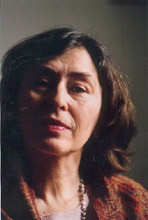Ellen and Jim Have a Blog, Too
We are two part-time academics. Ellen teaches in the English department and Jim in the IT program at George Mason University.


Reading _Pride and Prejudice_ in Teheran · 30 June 07
Dear Harriet,
One of the people commenting on my letter about Bottomer’s book about possible autism in Jane Austen’s depictions of favored characters asked why I thought Austen’s novels are popular in Muslim communities. She wanted to know “what evidence there is, overall, for Jane Austen offering virtual empathy to women in traditionalist Muslim and other extremely patriarchal societies with extramarital sex taboos? Anybody done research on this?”
I am, first of all, not sure how popular Austen’s novels are, but do know a number of popular Western books for girls are read all over the world in English translation (e.g., Nancy Drew mysteries in Nigeria), and that all Austen’s are translated into Farsi. Those few conversations I’ve had with (admittedly Westernized) young Muslim women, reveal the girls have not just heard of Austen but read at least one or more of her novels; the existence of I have found it and Bride and Prejudice (Bollywood free adaptations of Sense and Sensibility and Pride and Prejudice respectively), suggests Indian film-makers assume an intimate enough acquaintance with these books such that the females in the audience will quickly recognize how the modern analogous situations refer back to Austen’s two novels.
I responded:
“I was going to say I don’t know but I just thought of Reading Lolita in Teheran which could have been equally called Reading Jane Austen in Teheran as the fourth chapter is about reading Jane Austen with her Iranian young women students. Nafisi used Pride and Prejudice in particular intelligently and tactfully (as she did all the books she read with her students), and she and her girls related what they read in Austen to their own lives.”
I here add some details, or a summary and commentary on Nafisi’s remarkable Reading Lolita in Teheran and its relationship to Jane Austen’s books.
Azar Nafisi
The last quarter of Azar Nafisi’s Reading Lolita in Teheran includes a reading or interpretation of Jane Austen’s novels. Reading Lolita in Teheran is partly a misnomer since only the first chapter of the book is about Nabokov’s book and Nafisi and her students’ reaction to it; the second section concentrates on Fitzgerald’s The Great Gatsby, the third on Henry James, with excursions here and there on other Western American classics covered during her two bouts of public teaching in Teheran and the time of secret private teaching.
Not altogether for Nafisi reads Lolita as an ironic book which exposes a cruel man’s obsession with a young girl and his exploitation and abuse of her (and murder of her mother). It thus becomes a central text because her withdrawal from teaching and her girls’ life experience had just been radically altered by the reintroduction of the harsh and oppressive Sharia customs for women. These have the effect of isolating women within their families with no recourse to help outside these families from state or community organizations. They can become vulnerable sex objects whose sole aim in life is to please and obey the male authority figures in their family, to serve what the authority figures in the them say is the family’s interest. One of the word games played for light relief in the group was based on the oft-quoted opening line of Pride and Prejudice:
“It’s a truth universally acknowledged that a single man in possession of a good fortune must be in want of a wife.”
All the girls gave their version, but the one I remember is the most macabrely satirical one:
”’It is a truth universally acknowledged that a Moslem in possession of a good fortune must be in want of a nine-year-old wife’.”
The regime had dropped the legal marriageable age for girls from 18 to 9. No wonder, then, that Lolita should be a central reference point for the book.
Early on in her fourth chapter Nafisi tells the story of how she and her girls first had the idea of forming a separate group apart from the larger class to read and to discuss novels together. The book they wanted most to read together was Jane Austen’s Pride and Prejudice. Its tone inspired them to begin by talking about dancing and then dance: the mode was celebratory sexy “Eastern” dancing. Nafisi says this form of dancing offers a “unique” seduction, “such a mixture of subtlety and brazenness” as is not to be found in Western sexy dancing. Nafisi melted Austen’s tone and culture into a more familiar Eastern one. I don’t know what the translations of Austen into the many Muslim languages are like—nor even if Nafisi’s girls all read Austen in English. A translation might well alter Austen’s tone to make fit into feelings, behavior and rituals rooted in say Iranian communities.
She then saved this discussion and book for her last chapter. In this fourth section of her book (a kind of culmination of the whole), Nafisi suggests for women the problem of marriage is at the center a question of freedom. How women get to choose who will be their life partner limits their existence from the time of puberty (and before) to their death. The life of a Muslim widow is also strongly restricted by customs. Nafisi counterpoints the discussion of Pride and Prejudice with telling the reader what happened to women during the revolution. For women the streets had become a war zone of humiliation and physical punishment which could lead to arrest and then beyond imprisonment, flogging, raping, beating, torture, even execution. Women were subjected to punitive body searches when they turned up to go to class at university. There was a return to open barbaric practices, e.g., a woman is put in a sack and then shot and stoned to death in public.
One of the young women in Nafisi’s group is coerced into marrying someone she doesn’t care for at all, and Nasifi and the girls find solace and validation for their sense of violation, the destruction of a life, and as long at least as we know the girl flat misery (as I recall he is also domineering and has the right to beat her) from Austen. Charlotte Lucas’s marriage to Mr Collins was an important focus for their conversations. Even if she chose this marriage, it was felt she was pushed into it by intense pressure from her family for her to marry and also desperation, need, and disillusionment herself.
More generally, we see all her young women students intensely involved in deciding who to marry (for most of them it does not seem to be a question of whether to marry); we see one of them get engaged after a series of relatively brief social encounters where they are surrounded by others; we see the miseries of marriage (in this case one woman student is beaten by her husband), the pressures of family life (this is something they are seeking relief from). Nafisi has a character (based on a real male) who is a fatuous simpleton and continually misreads books; he is Bafisi’s strawman throughout (after a while his misreadings get a bit too predictable) and is of course called “a Mr Collins.”
As teacher of course Nafisi gets to set the terms of the discussion, and it was probably she who brought out the parallel of love of dancing by girls in Eastern cultures to love of dancing by girls in Western one. Her clear pleasure in “Eastern” dancing, her idea it’s really superior to Western dancing (sexier, more aggressive because more “calculating,” “sophisticated” than say the dancing poor Daisy Miller engages with), her connection of it to dancing in Austen’s novels suggests Nafisi finds much sexual nuance in Austen’s texts. I also find much sexuality suggested by Austen indirectly and directly. Nafisi, though, apparently thinks of Darcy as overtly and centrally very sexy (she must’ve loved Colin Firth in the 1995 film), and she asserts all her “girls” wanted to be Elizabeth. They also read scenes in Austen in somewhat of D. W. Harding and other serious critical writers: they found many of them to be about the daily cruelties people inflict on one another and endure. Austen dramatizes the outrageousness of the way we treat one another at times—through not acknowledging it. They thought the central theme of Pride and Prejudice was about about pressure on young women to marry.
Nafisi’s Reading Lolita in Teheran is also one of the books we’ve read & discussed on Women Writers through the Ages at Yahoo, and I have some comments by members of that list about this section to add here. Fran wrote that what
“struck me on finally re-reading the last chapters for comment yesterday, was that Nassrin [one of Nafisi’s young women students] says that ‘girls like me,who have read their Austen and Nabokov and all that, who talk about their Derrida and Barthes and the world situation – how we know nothing about the the relation between a man and a woman, about what it means to go out with a man.’ All their experience is vicarious, second-hand, due to the enforced segregation of the sexes, and in the same chapter Nafisi comments that Nassrin doesn’t seem to know how to move naturally without the chador – it as if the chador that hid her fron the sight of men had also alienated her from her own body.
It struck me, too, that the theme of finding a substitute emotional world in literature (and often the dangers attendant on it) is one linking a few of the books I’ve either just read (Sand’s Horace) and reread (Coetzee’s Disgrace) or will be rereading soon: Flaubert’s Madame Bovary, a book which itself brings the circle back to Nafisi, not only being one she references several times, but itself one put on trial [in her public classroom] for its immorality.”
Interestingly, Nafisi’s most conservative religious student doesn’t want to marry; she wants to spend her life otherwise in service for her community. Nassrin herself is the only other person besides Nafisi to leave Iran or its lifestyle—the other exception is a girl who was in Nafisi’s public class is raped and murdered in prison. Nafisi herself (and her husband and children) leave with money and belongings intact; they flee in the night.
As I have just finished watching the 1979 BBC Pride and Prejudice (screenplay Fay Weldon) and found that this adaptation makes this pressure more central and harassing and troubling (considering not only the happy ending of Jane and Elizabeth but the bleak ones of Charlotte, Lydia [fool though she is right now] and Mrs Bennet), I think the older BBC P&P film would please Nafisi’s students too and perhaps speak more to their emotional and existential concerns. Fay Weldon pictures a world of women, many scenes are added which bring out this angle (which is in Austen’s book though not in the same emphatic way).
A few stills: repeatedly young women are pictured in Elizabeth’s room looking out her window and often with their hands or bodies entwined. Here are Charlotte Lucas (Irene Richards) and Elizabeth Bennet (Elizabeth Garvie) early in the film looking out over the Longbourne property just after Charlotte tells Elizabeth that happiness in marriage is a lottery game:
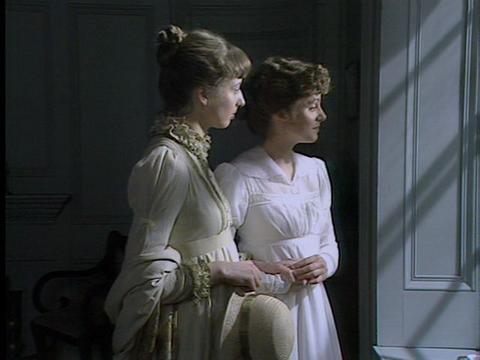
When the Gardeners come to visit the Bennets for the first visit (Xmas), we have a long scene of the women in the parlour (which is perpetually photographed against a window with thin bars and a cage with a bird in it):
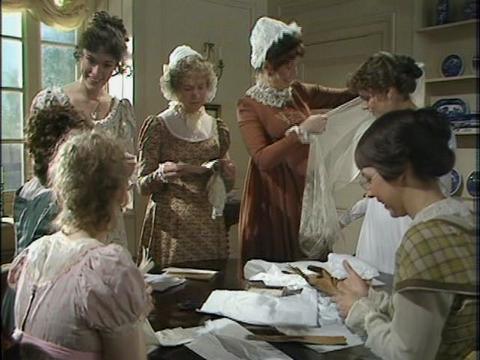
This kind of scene, one of women together in intimate discourse which is often slightly vexatious and competitive as well as supportive, recurs over and over in the film. Here is Elizabeth refusing Mrs Bennet’s (Priscilla Morgan) request that she, Elizabeth, ask Mr Bennet for money for wedding clothes for Lydia. The brilliance of the shot is in including Kitty (Clare Higgins) sitting by the window looking out:
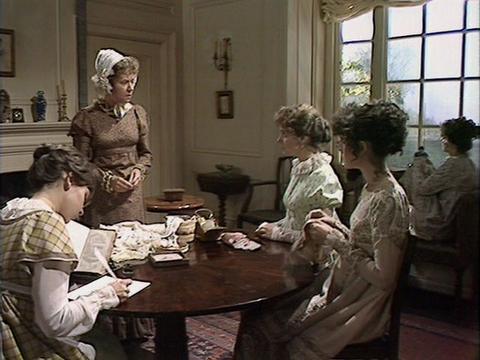
It’s probably important to remember (or know) that Nafisi picked the students she chose to have in her home and discuss great Western novels with. She chose a group of very intelligent sympathetic students who loved to read and were clearly westernized to start with. It was an ideal situation. They are also all of them desperate for her as mother hen & comforter too. I wondered what the mothers, sisters, and aunts of this particular group were like. Nafisi never brought that up. Perhaps reinforcers of misery—as many women are in many communities, more than complicit, active on behalf of represssion as instinctively they like males who are powerful for whatever reason, and want such types as husbands since this may make feel this gives them power over others.
In the book Nafisi begins by alluding to Muriel Spark’s The Prime of Miss Jean Brodie who also referred to her students as her girls. The comparison is apt, for even if they never betrayed her nor she them, she did worry about this and so did they.
Nafisi’s presentation of the experience of teaching in all the sections of the book was interesting—though perhaps (as one member of WWTTA suggested) she was not entirely candid either. I never believed that she didn’t get comments on the books that were completely outside her academic way of talking and showed her students read the books very differently than any of the outlooks she discussed. She alludes at the close of her book to Muriel Spark’s Loitering with Intent. This novel cum autobiography is about how much fiction you have to put in an autobiography to make it dramatic; how you have to shape and point it.
As has been said in a review more recently, Nafisi is also self-interested and writes from a privileged, elitist point of view. Her Pro-Western and pro-capitalist outlook are central to her success in the US and are at the partly unexamined core of her book. Nafisi never once refers to the intense poverty, the lack of any justice in getting a job, that underlies the revolution in Iran. The Shad was attempting to carve out some secular neutral space for meritocracy; this would have led not just to the first opening of freedom from familial tyrannies, but a place in the society where progress in technologies can actually take place where are not tied to militarism or a profession of religious belief. She simply doesn’t care about this or she actively is hostile to anything that smacks of “Marxism.” Socialism is an automatically suspect concept in her book. What was important to her was her father was a mayor of Teheran during the Shah’s regime. I know she says she was militant herself and idealistic when young, but I found no proof of any concern for the amorality of capitalism and the class systems it supports, both of which kept her & her family on top before the revolution.
Nafisi’s memoir “in books” (the subtitle of the book) reminds me of the aristocratic French women’s memoirs about the 1790s revolution in France, which just about uniformly condemn it. (See my letter on Blood Sisters: The French Revolution in Women’s Memory.) More specifically, she is content to breeze of the presentation of ulgy domineering sex in Lolita and never considers that the irony on Nabokov’s part is a pretense (certainly the film-maker must have thought so). (She is more accurate when she discusses his “Invitation to a Beheading” and “The Magician’s Assistant” wher ethe theme is how great how literature can support you when nothing and no one else does.) She rejoices in the wealth and luxury of Daisy and Tom in Great Gatsby; argues it doesn’t matter how hollow were the things Gatsby won, as long as he had his beautiful dream. Henry James’s Daisy is simply “entrancing.” I’ve seen women belly-dancing in the US and elsewhere and they do it for money and men come up close to them and put bills on their bodies to get them to come close and respond to them. Nafisi never had to do this kind of thing for a living.
All that said, this is an important book for young women to read today. It has a heroic teacher at the center, and eloquent life-writing about serious issues today. It has two subjects: the application of intelligence, feeling and work to make a book come alive to speak to the people reading it together; a portrait of daily life under absolute despotism and what this does to individuals and their groups as groups too. Nafisi was particularly good on what such experiences do to people, jailer, soldier, & torturer and the victim who wants out. For example, she tells of one girl taken prisoner:
“Her jailors jokingly suggested that since she was wearing an extra garment, she might not feel the pain, so they gave her more. For her, the physical pain had been more bearable than the indignity of the virginity tests and her self-loathing at having signed a forced confession. In some perverse way, the physical punishment was a source of satisfaction to her, a compensation for having yielded to those other humiliations.”
Although she generally avoids the word feminism, and choses to read men’s books as if their vision was universal, she often refers to books by men and male authors who have been important to women, even if hostile witnesses as (I think) Nabokov is. In his essay on Mansfield Park he mocks the tone he hears in it (cozy, genteel, lady-like) and shows his dislike of the traditional heroine of women’s novels, the ideal sensitive exemplar who is a victim and thereby exposes the power structure which controls and uses her.
My favorite section, however, was not the one on Austen, but the one on Henry James’s himself in his letters and as we can discern his narrator in his novels. Key characters in James are those who retreat to make a sanctuary, like Clare in The American. James’s family was involved in the brutal slaughters of the American civil war. In the teeth and understanding the inhumanity of what was happening (admittedly no worse than slavery), like Whitman (though not working as a nurse), James visited hospitals. Nafisi connects James’s statement about his experience to the indifferent reaction of many to the horrors of torture and death and in particular one of her students:
”’I confess that I have no philosophy, nor piety nor patience, no art of reflection, no theory of compensation to meet things so
hideous, so cruel, and so mad, they are just unspeakably horrible and irremediable to me and I stare at them with angry and almost
blighted eyes.”
I also love this. Nafisi quotes the hero of James’s The Ambassador as telling another character ”’I’m a perfectly equipped failure,” to which the other characters responds:
”’Thank goodness you’re a failure—it’s why I so distinguish you! Anything else today is too hideous. Look about you—look at the successes. Would you be one …’”
He and she are not outsiders, her “superiority” announces her “futility,” and what he and she are are “beaten brothers in arms.”
I have come away from Muslim women’s reading of Austen. I return to my first reponse to repeat that the idea that the picture of 18th century society we get from Austen (much less the movies and sequels) is anything like the real world at the time is wrong. Austen presents a tiny sliver of society in a self-censored way. Lafler’s book on the life of Anne Oldfield gives us a much more probable account of a woman’s life (including the pressure to have sex, need for a man, difficulty of getting paid or having access to an income undoubtably earned by you).
Scheherazade breaks the cycle of violence by telling stories. Like a number of later 18th century women writers (Isabelle de Montolieu among them), Nafisi likens herself to Scheherazade. (Ellen Moers says the figure of Scheherazade has been important to women who write about themselves as heroic teachers or whose heroine is a heroic teacher.) We in the US do live in a culture which popularly denies meaning and significance to literary works unless they make money by selling to masses of people through low means (sex and violence), often (as on TV ads) a debased world of gross mawkish sentimentality, antifeminism and pornified dress.
Here then is one last still for this letter from the 1979 BBC P&P, Charlotte Collins (nee Lucas) rushing out from Hunsford upon the long-awaited arrival of her friend, Elizabeth:
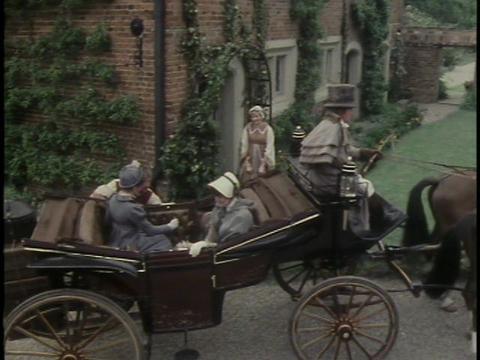
She has been watching eagerly for her from her window, very lonely for some real company. She decided she must live with and (as we see in this film) obey and allow herself to be impregnated by an ostinate obtuse man upon whom her security depends because he was the only reputable man who came her way who asked. But now she may enjoy a momentary reprieve.
Sylvia
--
Posted by: Ellen
* * *
Comment
- In order to suggest what a probable life of a woman can look like I put here as a comment my review of The Celebrated Mrs Oldfield by Joanne Lafler; I wrote this as a posting to ECW last week.
Dear all,
I know I’ve recommended this one before but as I’ve finished it now and am about to put it away (under “O” next to Gay was the Pit, a biography in the old semi-salacious stereotypical thinking style), I thought I’d say why. Lafler has two central important sources: shortly after Oldfield’s death (in her late 40s, she was not long-lived), The Authentic Memoirs was published (1730), and one year later a Curll concoction, possibly put together and partly written by him, The Faithful Memoirs. Without these two books, we would have the same blank we have for many other actresses beyond the list of plays they played in and the kind of documentation one can find for people in the early 18th century (proved wills, some documentation for where they lived, some for relatives when it’s a woman); but these books are filled with rumor and conjecture and slander and much cliched thinking.
What Lafler had to do was depend on Oldfield’s fame and the list of plays she played in. This was a great help and she industriously read all the plays and in part this is a book which retells the history of the early 18th century theatre from the point of view of a particular actress’s life and work as an actress. She goes further by working at (and this takes intuitive tact and intelligence) separating out fact and probability from fiction and legend in the two memoirs. She used Gay was the Pit as Gore-Brown did original research, only he didn’t provide a bibliography (very hard to examine his book then but she did her best getting from him what she could). And she is steeped in the memoirs of the period. Colley Cibber’s is essential reading to start with only. She did have many papers about Arthur Maynwarning, the first man Anne lived with, and about Charles Churchill, the second.
What is so commendable is a believable portrait of a real woman emerges. A working career woman who had (in effect) an open marriage or partnership with two men who respected her as an actress working in the theatre and companion. She had children by both. We can gauge some of her feelings from her will. We have to take with a grain of salt sayings attributed to her about her preference for comic roles: this is a stance and she was equally good and renowned for the tragic, and especially for her ability to do a tragic role and then turn round and deliver a ribald mocking parody of the part (in the popular undercutting epilogue mode).
If anything is missing, it seems to me that Lafler doesn’t sufficiently try to imagine what was Oldfield’s talent or skill on stage, how she drew her crowds to her. There is not a lot of evidence in the form of description and unfortunately this is an era where language is still generalized so it’s hard to get content.
But there’s enough. I thought I’d close this brief commentary by citing what I wrote in a conference paper. I point out Oldfield was thought to speak the mocking epilogue particularly well (there are four I describe, one by Anne Finch, one by Mary Wortley Montagu, one by Rowe and one by Pope): all four make fun of the attitudes of mind and characters in a group of tragic plays:
“Pope and Rowe’s epilogues exploit the mythic archetype underlying these portraits of glamorized penitent punished heroines: in modern terms, the “gratifying and reassuring” “myth of the slut.” Revealingly, all four epilogues were written for Anne Oldfield who was able to encompass roles on and offstage as diverse as the stereotype of the “upper class toy and pet,” conventional self-sacrificing mother, and sexually-transgressive victim and example. After having read a number of Oldfield’s most famous roles, I’ve concluded she was a virtuoso at self-conscious playing with hostile configurations of female sexuality. She was able to project these roles as forms of masquerade she took a perverse pleasure in. Tollet’s Ovidian epistle [a serious poem critiquing these plays, and about Anne Boleyn) provides a rare if muted woman’s text which shows this stereotype to derive from cruel and shallow analyses.
Anne Boleyn and Jane Shore have long pseudohistories fitting them into this archetype; in this they are typical of the sexually-transgressive woman who becomes fodder for such myths. She also was a past mistress at pleasing men by imitating the false stereotypes of alternatively cunning and submissive complicit female sexuality in "capital" parts of the day like Lady Betty Modish (Cibber's Careless Husband) and (frigidity too) in Lady Towneley (Van Brugh's Provok'd Husband.)"
Oldfield’s supposed reiteration that she took on tragedy roles with reluctance is interesting if you examine not just the context but the responses to this reiteration. She is quoted as saying that she put such “tragedy-faces” with reluctance; Doran (the mid-19th century historian of the 18th century stage) also asserts it was known that "she never troubled the peace of any lady at the head of a household." You see she was no threat. Readers are often hostile to writers out of envy. This is something not often enough discussed. Well, audiences are hostile and suspicious too.
E.M.
— Elinor Jun 30, 6:51pm # - ” … only just scanned stuff on Nafisi but very interesting, all of it. Think I need to check your blog all the time!
Eva Salzman”
— Elinor Jul 2, 10:48am #
commenting closed for this article

